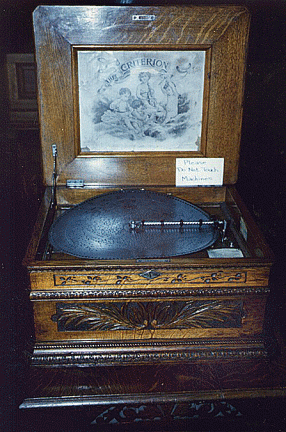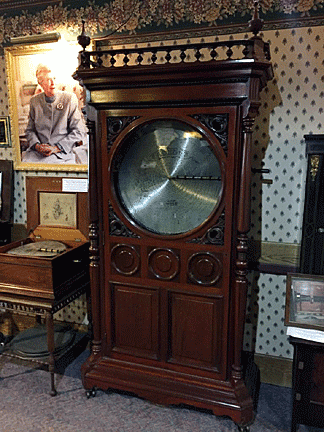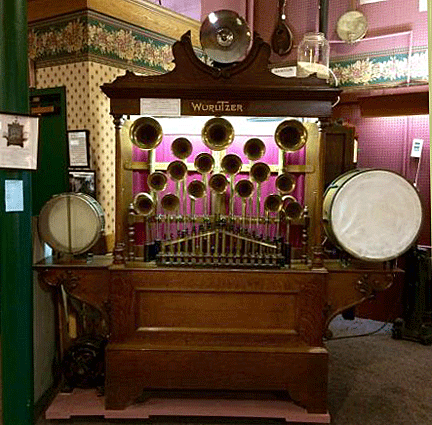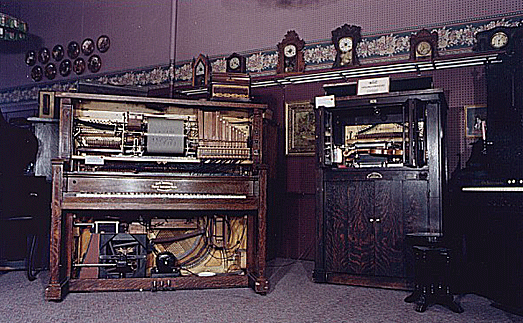|
Virtuoso Museum
by Bob
Brooke
Where can you go to hear the lilting
strains of beautiful music from the late 19th to the early 20th
centuries? Believe it or not, Franklin, Pennsylvania, home of the
DeBence Museum. With 100 antique mechanical musical instruments—most of
which still work and are the last of their kind—it’s a truly unique
museum.

Instead of just wandering around looking at the instruments, you get to
hear them on a guided tour. These old instruments—the oldest dating back
to 1850—still make beautiful music.
 You’ll
marvel at the range of sounds coming from these grand old players, from
the tinkling of a Swiss music box where little enameled bees strike
saucer bells to the roar of a Wurlitzer band organ. You’ll
marvel at the range of sounds coming from these grand old players, from
the tinkling of a Swiss music box where little enameled bees strike
saucer bells to the roar of a Wurlitzer band organ.
If you’re a history buff, these machines will take you back in time to
the Gilded Age. Imagine Queen Victoria listening to music like this with
the ladies of her court.
Some of these innovative musical instruments have animated parts. As the
disk turns on a hand-cranked phonograph, Billy Banjo dances. And if you
like mechanical gizmos, you’ll have a ball trying out how they work.
Simple Beginnings
 This
amazing little museum began simply. Jake and Elizabeth DeBence, dairy
farmers from Grove City, PA, went to an auction in the 1940s and came
home with two Tiffany- style lamps that they bought for very little.
This was at a time when country auctions were full of all sorts of
treasures. This
amazing little museum began simply. Jake and Elizabeth DeBence, dairy
farmers from Grove City, PA, went to an auction in the 1940s and came
home with two Tiffany- style lamps that they bought for very little.
This was at a time when country auctions were full of all sorts of
treasures.
They got hooked on auctions and kept going and their collections
continued to grow. At the same time, they began to buy Tiffany lamps.
And the rest, as they say, is history.
In 1965, they retired to Franklin in Venango County and displayed the
collections in their barn. When Jake died in 1992, Elizabeth put the
collection up for sale. She turned down a $13 million offer from a
Japanese interest because she knew Jake would have wanted his collection
to stay near home.
Local residents stepped in—raising $1 million in a matter of months—and
purchased the collection. It's now housed in what was once the town's
five and dime on the main street. It has one paid staffer and a group of
volunteers who repair and care for the instruments. Forty Tiffany-style
hanging lamps shed light on it all.
One of a Kind
The rarest instrument—and the only one of its kind in working
condition—is a 1912 Berry-Wood A. O. W. Orchestrion. It was the largest
orchestrion built by the Kansas-based BerryWood Piano Player Company and
was probably used in a motion picture house.
The equivalent of a 10-piece orchestra, it's played by a paper roll.
Beautifully crafted of teak and stained art glass panels, the instrument
has 34 wood flute pipes, 34 violin pipes a kettle drum, castanets,
cymbals, triangles, snare drums, a tambourine and a mandolin.
Loud, Strange and Breathy
 The
loudest piece in the museum is a 1928 Wurlitzer merry-go-round organ
that spent most of its life in Cabana Beach Amusement Park in
Washington, PA. The
loudest piece in the museum is a 1928 Wurlitzer merry-go-round organ
that spent most of its life in Cabana Beach Amusement Park in
Washington, PA.
There's a self-playing violin from 1911. It's said that President
William Howard Taft thought it was so special that he got Congress to
declare it one of the eight great inventions of the year.
The museum has quite a few player pianos whose keys play in ghostly
isolation, directed by perforated paper rolls. But there's also a piano
player that looks like a heavy bench with wooden fingers. You push it up
in front of a regular piano and it plays the keys from its own paper
roll. This isn’t a player piano, but a piano player with wooden fingers.

Calliopes get their power from compressed air. Music erupts from the
Air-Calio Calliope’s brass pipes. Only three of these instruments were
made in 1927. This one spent some time at Kennywood Park near
Pittsburgh, Pennsylvania and is the last one still playing.
Then there’s the horse race piano which began life, without music, as a
betting machine in the 1920s. When gambling became illegal in
Pennsylvania, its inventor added the piano component. Customers dropped
money in and got music and a horserace. Betting took place on the side,
probably in a speakeasy.
The museum is still adding to its collections. The lower level has a mix
of radios, organs and juke boxes. The second floor houses more pianos
and organs and the shop where volunteers work on the instruments. On the
third Sunday of each month, except August, there's usually a concert on
the third floor.
<
Back to More Antiques to View
Next Article > |
